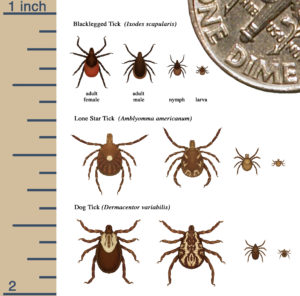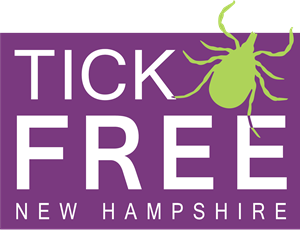Identify

CDC’s Tick identification chart illustrates the size and appearance of the Blacklegged Tick (commonly known as a “Deer Tick”), Lone Star Tick* and Dog Tick at larval, nymph and adult stages.
Fact Sheet: Biology and Management of Ticks in New Hampshire
University of New Hampshire Cooperative Extension
The UNH Cooperative Extension provides research-based information and education to New Hampshire residents on topics important to the state. This publication will help you learn what ticks look like, how they live, the diseases they spread, how to manage tick problems, and how to protect yourself from tickborne diseases.
TickEncounter Resource Center
University of Rhode Island (URI)
The TickEncounter Resource Center promotes tick bite protection and tickborne disease prevention by engaging, educating, and empowering people to take action. This resource will provide you with information on preventing tick encounters, an up to date tick finder tool, as well a variety of tick identification and testing resources.
Tick Identification Guide
University of Rhode Island (URI)
This publication will help you to identify different tick species by describing the differences in size and appearance of tick parts at different life stages among different tick species.
Blacklegged Tick (Deer Tick) Life Cycle Chart
University of Rhode Island (URI)
This diagram shows the life cycle of blacklegged ticks that can transmit anaplasmosis, babesiosis, and Lyme disease. Blacklegged ticks are the most common vector of Lyme disease. This resource emphasizes the importance of knowing what this tick looks like at all stages of its life and where you are most likely to encounter one.
UMass Laboratory of Medical Zoology
University of Massachusetts (UMass)
Use the UMass Laboratory of Medical Zoology’s website, TickReport.com, for reliable, high quality tick testing with the lowest cost and fastest turn-around time in the industry.
BeBop Labs
BeBop Labs is a volunteer-run organization which is collecting, identifying, and tracking areas with heavy tick populations and tick-borne diseases. This organization provides free tick testing for individuals who mail in their specimens.
TickID: Know them. Prevent them.
New Hampshire Division of Public Health Services
Don’t miss a tick! This reference card will help you identify tick species, perform proper tick removals, and provide you with information on the spread and symptoms of tickborne diseases.
The New Hampshire Department of Agriculture, Markets & Food
The New Hampshire Department of Agriculture, Markets & Food offers free tick identification to New Hampshire residents. The intent is to monitor the distribution of tick species in New Hampshire. To submit your sample, complete the Tick Submission Form and mail the tick and form as described. Ticks submitted will not be tested for disease-causing pathogens.
